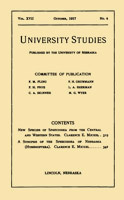University Studies of the University of Nebraska
Date of this Version
1939
Citation
Published 1939 by The University of Nebraska. Printed in the United States by the University of Nebraska Printing Division.
Abstract
This paper deals with the anatomy and histology of the digestive tube of one of the grenadiers or rat-tails, Coelorhynchus carminatus (Goode), as classified by Jordan & Evermann (1896).1 Many studies on the structure of the digestive tracts of fishes have been made in the past, and pioneer work in the teleost group was done by Valatour in 1861, Pillet in 1894 on the Pleuronectidae, and Gulland in 1898 on the salmon. More recent studies have been made by Greene (1912) on the king salmon, Blake 2 (1930) on the sea bass, and Rogick (1931) on the minnow.
The species under consideration is very little known; the literature is scanty, and in most instances only the name is mentioned, with no appended description. It belongs, however, in the family Macrouridae and is a deep-sea fish, living at a depth of 200 to 315 fathoms. It is described as having an elongated, silver-gray body, a leptocercal tail ending in a long filament, scales with spines arranged in rows, fig. 1c:, like woolcards (carmen), a long, sharp, depressed triangular snout, and large eyes, fig. 1a.

